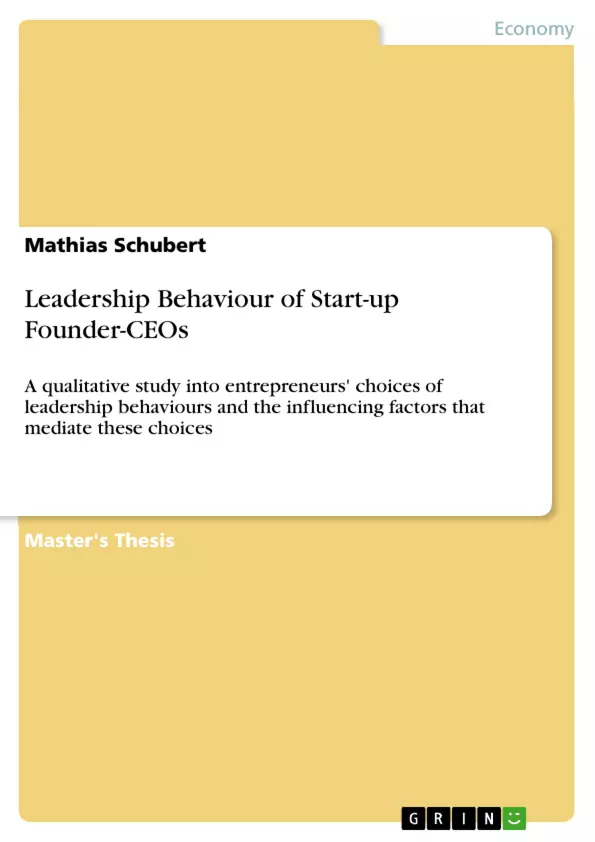Scholars only recently recognised the fact that new entrepreneurial ventures (i.e. start-ups) cannot be created and grown without the leadership of founders who initially formulate the vision and strategy of their organisations, set particular goals, and motivate and manage the efforts of their employees. Present research has mainly focused on quantitatively relating specific types of leadership behaviours to positive or negative new venture performance outcomes while neglecting to understand how the new venture context influences the initial choices of entrepreneurs to lead in a certain way.
To close this research gap, this study examined the leadership behaviour of start-up founder-CEOs and the reasons for the practised styles through qualitative research. Transcripts of semi-structured interviews with 17 entrepreneurs who obtain the CEO (Chief Executive Officer) position in their start-ups were analysed using narrative interpretation. The study was conducted over a period of three months and sought to identify the participants' leadership behaviour by asking them specific indirect and direct questions that would reveal patterns of their leadership behaviour. The entrepreneurs’ leadership behaviour was then examined across the dimensions of vertical and shared leadership before identifying transactional, transformational as well as empowering and directive behaviours.
With the findings of this study, it is hoped that scholars, students as well as professionals can gain a better understanding of leadership practices in start-ups and why shared and empowering leadership behaviours are predominant. For future research, the results of this study highlight the importance of qualitatively examining entrepreneurs' leadership behaviour as well as further investigating the relationship between the new venture context and the demonstrated leadership behaviours.
Inhaltsverzeichnis (Table of Contents)
- Acknowledgements
- Executive Summary
- Table of Contents
- List of figures and tables
- 1 Introduction
- 1.1 Background
- 1.2 Objectives of this study
- 1.3 Layout
- 2 Literature Review
- 2.1 Introduction
- 2.2 Entrepreneurship in the New Venture Context
- 2.3 Bridging Entrepreneurship and Leadership
- 2.4 Leadership behaviours in the new venture context
- 2.4.1 Transactional Leadership within the New Venture Context
- 2.4.2 Transformational Leadership within the New Venture Context
- 2.4.3 Empowering Leadership within the New Venture Context
- 2.4.4 Directive Leadership within the New Venture Context
- 2.4.5 Vertical and Shared Leadership within the New Venture Context
- 2.5 A Case for Further Research
- 3 Methodology
- 3.1 Research Approach
- 3.2 Research Design
- 3.3 Research Strategy
- 3.4 Analysis of Qualitative Data
- 3.5 Research Limitations
- 4 Findings and Discussion
- 4.1 Introduction
- 4.2 Founder's duties in the new venture process
- 4.3 Shared & Vertical Leadership
- 4.4 Transformational Leadership
Zielsetzung und Themenschwerpunkte (Objectives and Key Themes)
This dissertation investigates the leadership behaviour of start-up founder-CEOs and the factors influencing their choice of leadership styles. The study aims to bridge the gap in research that overlooks how the new venture context impacts entrepreneurial leadership choices. It uses a qualitative approach with semi-structured interviews to understand the leadership practices of 17 start-up CEOs, analyzing their narratives to identify patterns and influential factors.
- The impact of the new venture context on leadership choices
- The relationship between founder-CEOs' duties and leadership styles
- The prevalence of shared leadership among start-up co-founders and top management teams
- The prominent role of empowering leadership in early-stage ventures
- The evolution of leadership styles as start-ups grow and mature
Zusammenfassung der Kapitel (Chapter Summaries)
The study begins with a review of the existing literature on entrepreneurship, leadership, and the interplay between these concepts in the context of new ventures. It examines different leadership styles, including transactional, transformational, empowering, and directive leadership, as well as the distinction between vertical and shared leadership. The methodology chapter outlines the qualitative approach, research design, and data analysis techniques employed in the study. The findings chapter explores the specific leadership behaviors observed in the study, focusing on the roles of founders, the prevalence of shared leadership, and the influence of the stage of development on leadership styles.
Schlüsselwörter (Keywords)
This dissertation focuses on the leadership behaviour of start-up founder-CEOs, examining their choices of leadership styles within the unique context of new ventures. Key themes explored include entrepreneurship, leadership, new venture context, shared leadership, empowering leadership, transactional leadership, transformational leadership, directive leadership, and qualitative research methods.
- Citation du texte
- Mathias Schubert (Auteur), 2016, Leadership Behaviour of Start-up Founder-CEOs, Munich, GRIN Verlag, https://www.grin.com/document/353504



